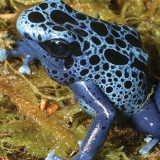RANGE:
Mexican Red-Knee – Mexico.
Chilean Rose-Haired – Chile, South America.
HABITAT
Live in burrows in semi-desert to desert regions.
SIZE
Body length is 1.2 to 2.75 inches, with leg span of 5 – 6 inches.
LIFE EXPECTANCY
Both sexes take 10 – 12 years to mature. Male lives one year after reaching maturity. The female may live 10 – 15 years longer.
REPRODUCTION
- Breed in September and October.
- In both the male and female, the genital opening is on the underside of the abdomen. In addition, the male has a pair of sex organs on the end of the pedipalps which are used to transfer sperm to the female.
- Female lays 500 to 600 tiny eggs which remain in the silk sac for 91 days.
- No maternal care beyond hiding and camouflaging the egg sac.
DIET
Carnivorous.
Wild: Insects, insect larvae, baby birds and mammals.
Zoo: Crickets and baby mice
BEHAVIOR
- Nocturnal.
- Hibernate through winter where there is a cold season.
- Fairly inactive; may be motionless for days.
- Line their burrows with silk but do not make webs.
STATUS
Threatened throughout its ranges due to pet trade.
POINTS OF INTEREST
- Tarantulas are the largest and most primitive of all living spiders.
- The exoskeleton does not grow with the spider, but must be shed from time to time. This process is called molting. For a short time after molting the spider cannot run and is in danger from its predators.
- They are able to regenerate missing appendages during the molting process.
- Hairs are highly sensitive and serve as organs of touch.
- They are not considered poisonous. The bite is painful but not fatal to humans.
- Spider resting heart rate is 30 – 40 beats per minute. After 30 seconds of activity it may increase to 200 per minute.



